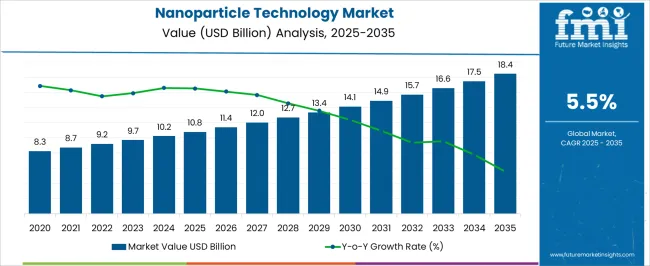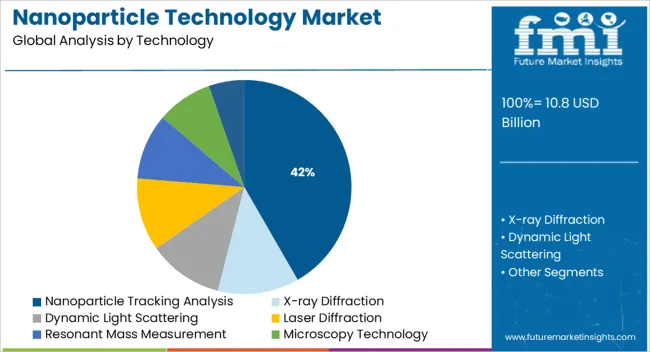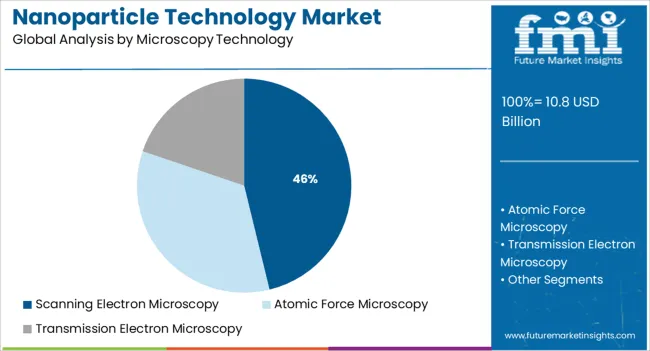The Nanoparticle Technology Market is estimated to be valued at USD 10.8 billion in 2025 and is projected to reach USD 18.4 billion by 2035, registering a compound annual growth rate (CAGR) of 5.5% over the forecast period.

| Metric | Value |
|---|---|
| Nanoparticle Technology Market Estimated Value in (2025 E) | USD 10.8 billion |
| Nanoparticle Technology Market Forecast Value in (2035 F) | USD 18.4 billion |
| Forecast CAGR (2025 to 2035) | 5.5% |
The nanoparticle technology market is progressing steadily, driven by its pivotal role across drug delivery, material science, environmental monitoring, and precision manufacturing. The growing use of nanomaterials in therapeutics, diagnostics, and renewable energy systems has placed nanoparticle characterization and analysis at the center of research and industrial innovation.
Increasing regulatory scrutiny over product quality and nanoscale material behavior is compelling companies to invest in advanced nanoparticle tracking and visualization tools. Parallelly, the expansion of nanotechnology applications in oncology, vaccine development, and high performance coatings is reinforcing demand for accurate, scalable, and reproducible nanoparticle analysis platforms.
With a surge in nanomedicine research and precision engineering, the market is expected to expand further as stakeholders prioritize better process control, material traceability, and analytical precision.
The market is segmented by Technology and Microscopy Technology and region. By Technology, the market is divided into Nanoparticle Tracking Analysis, X-ray Diffraction, Dynamic Light Scattering, Laser Diffraction, Resonant Mass Measurement, Microscopy Technology, and Others. In terms of Microscopy Technology, the market is classified into Scanning Electron Microscopy, Atomic Force Microscopy, and Transmission Electron Microscopy. Regionally, the market is classified into North America, Latin America, Western Europe, Eastern Europe, Balkan & Baltic Countries, Russia & Belarus, Central Asia, East Asia, South Asia & Pacific, and the Middle East & Africa.

The nanoparticle tracking analysis segment is projected to represent 41.70% of total market revenue within the microscopy technology category by 2025, making it a leading subsegment. This growth is driven by its ability to provide real time measurement of particle size distribution and concentration in liquid suspension.
The technique’s high resolution, dynamic range, and capacity to analyze heterogeneous samples without complex preparation make it ideal for applications in drug development, vaccine formulation, and biomedical research. The increasing demand for reliable characterization of extracellular vesicles and lipid nanoparticles has further boosted its adoption.
As researchers prioritize fast and statistically robust particle analysis, nanoparticle tracking analysis continues to gain traction across academic and industrial laboratories.

The scanning electron microscopy segment is anticipated to account for 46.20% of the total market share in 2025 under the microscopy technology category, making it the dominant segment. This is attributed to its superior imaging resolution, depth of field, and versatility in analyzing the surface morphology and composition of nanoparticles across solid substrates.
The technique’s compatibility with a broad range of materials including metals, polymers, and biological specimens supports its widespread use in materials science, electronics, and life sciences. Increasing investments in nanomaterial quality control and forensic level failure analysis are reinforcing its relevance.
As industries demand detailed visualization and elemental analysis at the nanoscale, scanning electron microscopy remains essential for precision diagnostics, failure investigation, and advanced material characterization, securing its leadership in the nanoparticle technology market.
The Global Nanoparticle Technology market is segmented on the basis of type of technology which includes nanoparticle tracking analysis, X-ray diffraction, dynamic light scattering, laser diffraction, resonant mass measurement, microscopy technology and others.
The microscopy technology is further bifurcated by scanning electron microscopy, atomic force microscopy and transmission electron microscopy. The others segment is also divided by differential mobility analyzer, condensation particle counter, nanoparticle surface area monitor and scanning mobility particle sizer.
The global nanoparticle technology market is also segmented on the basis of applications such as energy, cosmetics, electronics, defense, food and agriculture and biomedical. Cosmetic and biomedical segment is likely to observe significant growth during the forecast period.
Rising emphasis on nanotechnology research as well as increasing multinational corporations and private investors spending in research and development activities in pharmaceutical sector is anticipated to expand the growth of nanoparticle technology market during the forecast period.
Besides this, increasing number of events and conferences all across the globe regarding knowledge about newly technologically advanced nanoparticle instruments is likely to foster the growth of global nanoparticle technology market over the forecast period.
Geographically, Global Nanoparticle Technology industry can be divided by major regions which include North America, Latin America, Western and Eastern Europe, Asia-Pacific region, Japan, Middle East and Africa.
Significant number of clinical trials, availability of large number of biopharmaceutical and pharmaceutical companies as well as inclining research and development activities in the USA has strengthened the growth of North America nanoparticle technology market as it dominated the global nanotechnology market in 2020.
Europe nanoparticle technology market stood at second position in terms of revenue in global nanoparticle technology market in the same year. Rising spending by the Asian corporations on life science research especially in India and China is expected to strengthen the growth of global nanoparticle technology market in Asia from 2020 to 2029.
The significant potential in emerging countries such as India, South Africa and China for manufacturers is likely to boost the market of Asia Pacific and Middle East and Africa region over the forecast period.
Some of the top players identified across the value chain of the global Nanoparticle Technology include Nanophase Technologies Corporation, Altair Nanotechnologies Inc., Unidym Inc., Nanosys Inc., PEN Inc., Advanced Diamond Technologies Inc., and Bruker Nano GmbH.
The companies are entering into formulation of various business strategies in order to expand their portfolio in nanoparticle technology market.
Manufacturers are expected to incline their research and development expenses in order to gain the competitive edge in global nanoparticle technology market over the coming few years.
The report is a compilation of first-hand information, qualitative and quantitative assessment by industry analysts, inputs from industry experts and industry participants across the value chain. The report provides in-depth analysis of parent market trends, macro-economic indicators and governing factors along with market attractiveness as per segments. The report also maps the qualitative impact of various market factors on market segments and geographies.
The global nanoparticle technology market is estimated to be valued at USD 10.8 billion in 2025.
The market size for the nanoparticle technology market is projected to reach USD 18.4 billion by 2035.
The nanoparticle technology market is expected to grow at a 5.5% CAGR between 2025 and 2035.
The key product types in nanoparticle technology market are nanoparticle tracking analysis, x-ray diffraction, dynamic light scattering, laser diffraction, resonant mass measurement, microscopy technology and others.
In terms of microscopy technology, scanning electron microscopy segment to command 46.2% share in the nanoparticle technology market in 2025.






Full Research Suite comprises of:
Market outlook & trends analysis
Interviews & case studies
Strategic recommendations
Vendor profiles & capabilities analysis
5-year forecasts
8 regions and 60+ country-level data splits
Market segment data splits
12 months of continuous data updates
DELIVERED AS:
PDF EXCEL ONLINE
Lipid Nanoparticles Market Insights - Growth & Forecast 2025 to 2035
Silver Nanoparticles Market Size and Share Forecast Outlook 2025 to 2035
Platinum Nanoparticles Market
Cerium Oxide Nanoparticle Market Growth – Trends & Forecast 2024-2034
Metal Nitride Nanoparticles Market
Colloidal Selenium Nanoparticles Market Size and Share Forecast Outlook 2025 to 2035
Tungsten Disulphide Nanoparticles Market
Metal & Metal Oxide Nanoparticles Market Growth – Trends & Forecast 2024-2034
4K Technology Market Size and Share Forecast Outlook 2025 to 2035
5G technology market Analysis by Technology Type, Application, Vertical, and Region – Growth, trends and forecast from 2025 to 2035
8K Technology Market
Nanotechnology Photocatalysis Surface Coating Industry Analysis in AMEA Size and Share Forecast Outlook 2025 to 2035
Nanotechnology Packaging Market Size and Share Forecast Outlook 2025 to 2035
Key Players & Market Share in GDS Technology Market
GDS Technology Market Insights - Growth & Forecast 2025 to 2035
Nanotechnology for food packaging Market
Food Technology Market Size and Share Forecast Outlook 2025 to 2035
Smart-Technology Anti-Wrinkle Peptides Market Size and Share Forecast Outlook 2025 to 2035
Laser Technology Market Size and Share Forecast Outlook 2025 to 2035
Green Technology And Sustainability Market Size and Share Forecast Outlook 2025 to 2035

Thank you!
You will receive an email from our Business Development Manager. Please be sure to check your SPAM/JUNK folder too.
Chat With
MaRIA